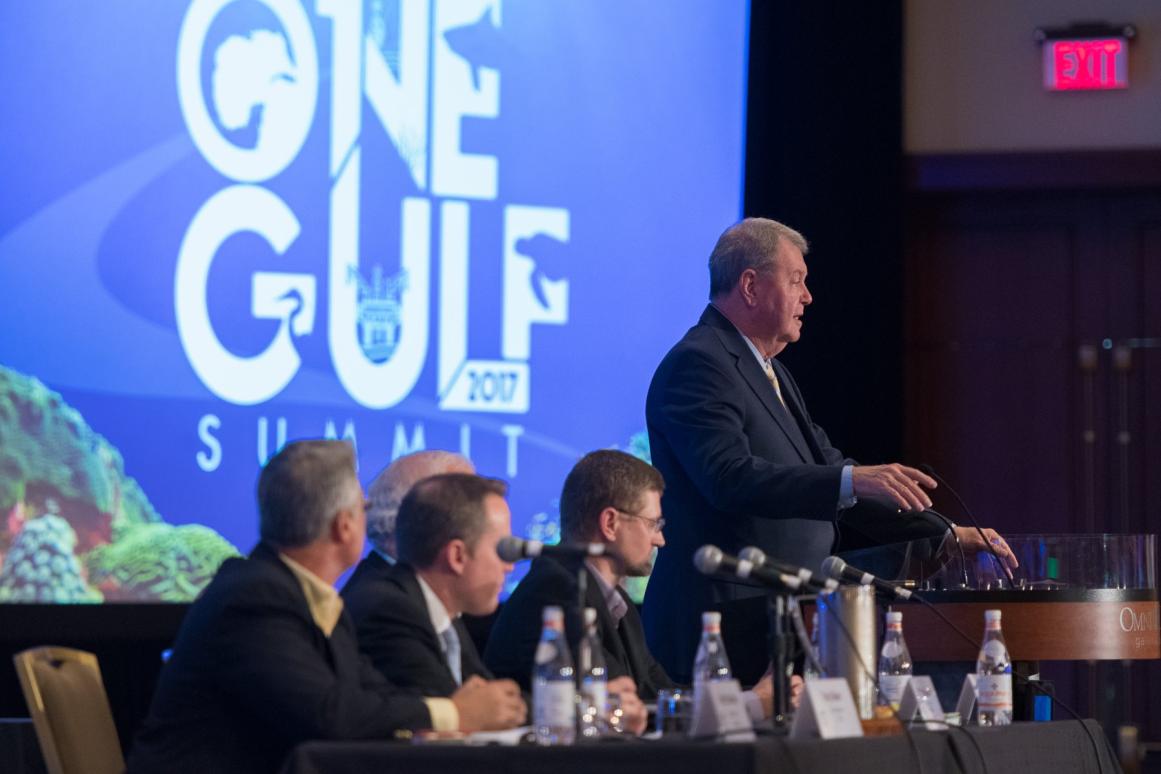Gulf Summit Promotes International Research Collaboration

CORPUS CHRISTI, Texas — The Harte Research Institute for Gulf of Mexico Studies (HRI) at Texas A&M University-Corpus Christi hosted one of the largest gatherings of ocean scientists from the U.S., Mexico and Cuba focused on international research collaboration at its fourth State of the Gulf of Mexico Summit.
A premier Gulf gathering hosted by HRI for more than 10 years, the State of the Gulf of Mexico Summit convened more than 380 international Gulf leaders and stakeholders from ocean sciences, policy, socioeconomics and conservation backgrounds to develop a common vision for the long-term economic and ecological health of the Gulf of Mexico. The Summit, held March 26-28, was immediately followed by the Gulf of Mexico Alliance All-Hands Meeting and the Gulf of Mexico Workshop on International Research on March 29-30.
“No other Gulf meeting brings together such a diverse mix of academia, resource managers, business, industry and policymakers with a common goal — the health and sustainability of the Gulf of Mexico,” said Dr. Larry McKinney, HRI Executive Director.
This year’s Summit, the first since Cuba signed a Joint Statement on Cooperative Environment Protection with the United States aimed at collaborating on environmental protection initiatives, also featured a distinct international focus. A delegation of nine Cuban scientists led by Dr. Maritza García García, President of the Cuban Environmental Agency, Ministry of Science, Technology and Environment, attended the event as invited guests of HRI.
The Summit and International Workshop also included more than 40 of Mexico’s best researchers and policy makers, with special presentations from Mexican research leaders like Dr. José Piña, President of Universidad Juárez de Tabasco and the Consorcio de Instituciones de Investigación Marina del Gulfo de México y del Caribe (CiiMAR-GoMC), Dr. Juan Carlos Herguera, Director of the Consorcio de Investigación del Gulfo de Mexico and Alejandro Carabias, Head of Regulations and Legal Standards in Mexico’s newly created National Agency for Safety, Energy, and Environment (ASEA).
HRI Assistant Research Scientist Dr. Victoria Ramenzoni has recently taken on additional duties as International Coordinator as the institute works to expand its cooperative research in Mexico and Cuba. Ramenzoni escorted and translated for the Cuban delegation during their time at the Summit, and she said that while international political policies are always in a state of flux and change, science is a constant that transcends physical borders and language barriers.
“The institute has reached a pivoting moment, when we need to be able to carry out projects across national and disciplinary boundaries,” Ramenzoni said. “Key to creating informed solutions is being able to see the Gulf as one, and that poses a daunting task: The ability to transmit our vision to different audiences, cultures, languages, and countries. Our international strategy ultimately seeks to get all of us — scientists and managers — on the same page so we can finally put the pieces together of this big fascinating puzzle that is the Gulf.”
This year’s Summit focused on three key issues: Integrating environmental health and human health for a better-functioning Gulf; how to best assess Gulf health to ensure a wise investment of restoration dollars; and looking toward the future beyond the $20 billion in Deepwater Horizon oil disaster-funded restoration projects that are currently moving into place. In a shifting political atmosphere that promises to offer both challenges and opportunities for international Gulf science, participants were looking for ways to work together and to support one another, McKinney said.
“I was very pleased that our international participants were so well received at the State of the Gulf Summit,” McKinney said. “It just proves that science diplomacy can bridge many gaps when there is a common purpose — the health and well-being of the Gulf of Mexico.”
The Gulf of Mexico Workshop on International Research (GOM-WIR), held March 29-30, brought together more than 170 researchers from the three Gulf nations for the first-ever workshop aimed at developing an international research agenda for the Gulf of Mexico. The objective of the workshop was to help fill critical information gaps in the Gulf through joint international environmental research, particularly in lesser-studied areas of the southern Gulf of Mexico. The workshop was organized by HRI; the Gulf Research Program of the National Academies of Sciences, Engineering, and Medicine; the Bureau of Ocean Energy Management; and the National Oceanic and Atmospheric Administration.
HRI Endowed Chair for Biodiversity and Conservation Science and Professor Emeritus Dr. Wes Tunnell, who has studied coral reef ecology and the environmental impacts of marine oil spills in Mexico, said connecting northern and southern Gulf of Mexico scientists was one of the most important outcomes of the Summit and the International Workshop. Through his work at HRI, Tunnell helped to pioneer the institute’s connections with Cuba, and an endowment in his name supports continuing student research in Mexico. He said that he hopes connections made at the Summit will stimulate research collaborations into the future.
“Having promoted science collaboration between Mexico and the U.S. for four decades, and Cuba and the U.S. for 15 years, it does my heart good to see the new connections and networks established during the State of the Gulf Summit and the Gulf of Mexico Workshop on International Research,” Tunnell said. “There is a real buzz of excitement that we might be moving into a new era of collaboration on research to better understand the entire Gulf of Mexico ecosystem.”
